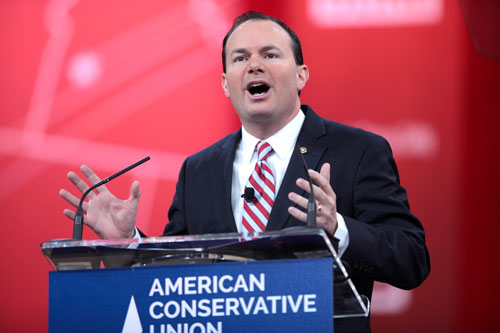Legislation to scrap America’s effective ban on the incandescent lamp has been introduced in the US Senate.
Republican senator Mike Lee says his bill is designed to ‘restore Americans’ freedom to choose the best lighting for their homes and businesses’.
The proposal would remove GLS lamps from the Department of Energy’s Appliance Standards programme and repeal three regulations that have removed incandescent lamps from the market.
It’s backed by five Republican senators.
Lee, chairman of the influential Senate Committee on Energy and Natural Resources, says the Biden-era regulations ‘have nothing to do with saving the planet’.
‘They’re about controlling people,’ he told the press ‘If the federal government can dictate the type of lightbulb you use, what can’t it dictate? Americans don’t need Washington to micromanage their light switches’.
Earlier this year President Trump signed an executive order which ‘safeguards the American people’s freedom to choose light bulbs’.
The order, dubbed ‘Unleashing American Energy’, is designed to remove ‘burdensome and ideologically motivated regulations have impeded the development of [natural] resources’.
Despite Senator Lee’s bill and the Presidential order, it would take an Act of Congress to overturn federal efficiency standards mandating a minimum efficacy of 45 lm/W, which incandescent sources fail to meet.
In his last term of office, Trump frequently railed against LED technology and vowed to bring back the traditional light bulb.
At a rally in Fayetteville, North Carolina in 2019, he said he looked ‘better under an incandescent light than these crazy lights that are beaming down’. He further claimed that if LEDs break they become ‘a hazardous waste site’ and are ‘very dangerous with all of the gases’.
His aim was to allow Americans to ‘go ahead and decorate your house with whatever lights you want’.
In the United States, energy efficiency regulations for light bulbs are primarily governed by the Energy Policy and Conservation Act (EPCA) and its subsequent amendments, particularly the Energy Independence and Security Act (EISA) of 2007. These laws set standards for the energy performance of lighting products, including light bulbs, to reduce energy consumption and greenhouse gas emissions.
The most significant regulation is the Energy Star program, managed by the US Environmental Protection Agency (EPA) and the Department of Energy (DOE).
This programme provides a certification label for energy-efficient products, including light sources that meet stringent efficiency criteria.
In 2012, new standards under EISA began phasing out traditional incandescent bulbs in favour of more energy-efficient alternatives like CFLs and LEDs.
It is these regulations which set the 45 lumens per watt minimum for general-purpose light bulbs.
The standards were gradually increased over the years, with the ultimate goal of reducing energy consumption and cutting electricity bills for consumers.
By 2020, most incandescent bulbs were replaced by more efficient options.
Additionally, states like California have implemented stricter energy efficiency standards beyond federal regulations to encourage the adoption of even more efficient lighting technologies.
• Learn more about sustainable lighting at Circular Lighting Live 2025, Recolight’s flagship conference and exhibition, which takes place on Thursday 25 September 2025 at the Minster Building in the City of London. Free to specifiers, Circular Lighting Live 2025 will feature leading experts, specifiers and policy makers who will share their insights into forthcoming standards and legislation, emerging technologies and new business models. More info: www.circularlighting.live
Picture: Gage Skidmore

